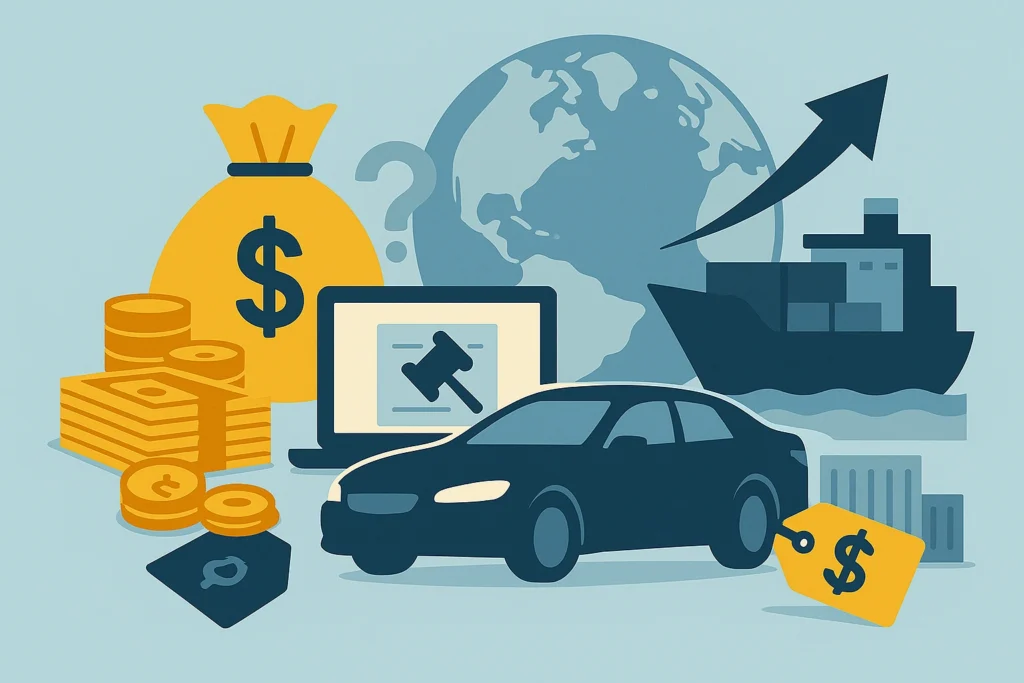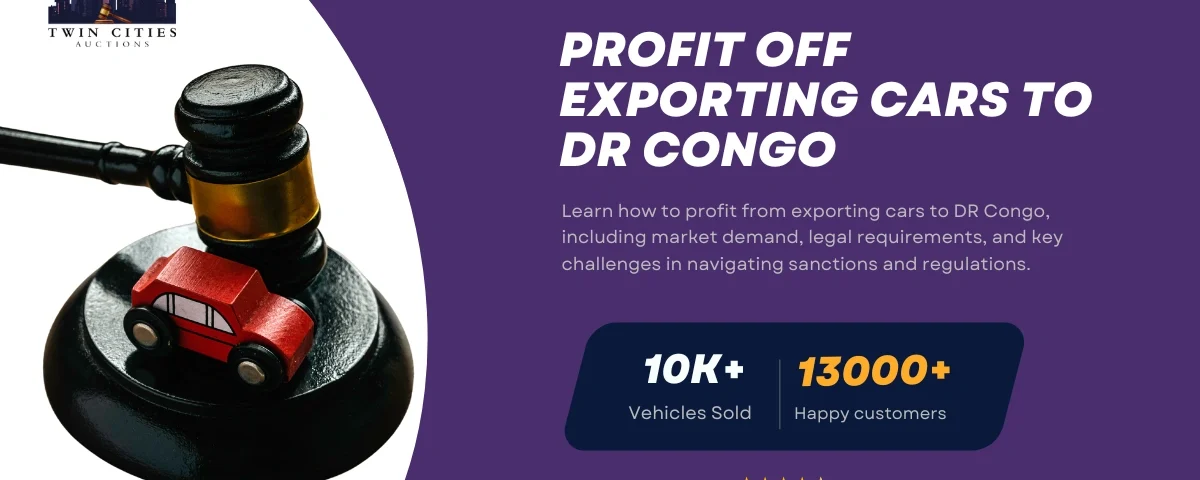Did you know the DRC imported an estimated 15 000 to 20 000 motor vehicles in 2023, valued at 90 million to 110 million US dollars and growing at around 8 percent annually?
US exporters tapping this demand have seen profit margins rise by up to 20 percent within six months. This guide shows you how to comply with DRC regulations, calculate costs, and manage logistics for maximum returns.

Key Takeaways
- DRC imported about 15 000 to 20 000 vehicles in 2023
- Import costs add roughly 46 percent of vehicle value
- Profit equals landed cost plus your margin
- Main ports are Matadi and Banana
- Required documents include invoice, bill of lading, import license, and certificate of conformity
- Best sourcing option is U S auto auctions
Understanding the DRC Market
The DRC’s vehicle import market is predominantly composed of used vehicles, with a significant portion originating from Japan. Importers often favor Japanese vehicles due to their affordability and reliability.
The demand is particularly high for compact SUVs and sedans in urban areas like Kinshasa, where fuel efficiency is a priority. In contrast, regions such as Katanga prefer diesel pickups to support commercial activities.
| Metric | Figure |
| Vehicles Imported | 15 000 to 20 000 units |
| Estimated Market Value | 90 million to 110 million |
| Year over Year Growth | Approximately 8 percent |
Source: DRC National Statistical Office
Regulations and Compliance
The DRC enforces strict regulations on vehicle imports to ensure safety and environmental standards. Imported vehicles must not exceed five years of age, and a Certificate of Conformity is required to verify compliance with safety and emission standards.
Additionally, importers must obtain an import license from the Ministry of Industry before proceeding with the importation process.
| Document | Purpose | Required For |
| Commercial Invoice | Declares sale value | All imports |
| Bill of Lading | Proof of maritime shipment | Sea‑borne imports |
| Import License | Government authorization | All vehicle imports |
| Certificate of Conformity | Verifies safety and emissions compliance | All imports |
Building Your Landed Cost and Profit Model
Accurate cost modeling is crucial for profitability in vehicle importation. Importers should consider the Cost, Insurance, and Freight (CIF) value, which includes the vehicle’s price, shipping, and insurance costs.
The DRC imposes an import duty of 30% on the CIF value, a Value Added Tax (VAT) of 16% on the sum of the CIF and import duty, and miscellaneous fees amounting to approximately 4% of the CIF.
These calculations are essential for determining the total landed cost and setting appropriate profit margins.
| Cost Item | Rate | Calculation Example (USD) |
| CIF Cost | — | 10 000 |
| Import Duty | 30 percent | 3 000 |
| Value Added Tax | 16 percent | (10 000 + 3 000) × 0.16 = 2 080 |
| Miscellaneous Fees | 4 percent | 10 000 × 0.04 = 400 |
| Total Landed | — | 15 480 |
Source: DRC Customs Authority
Add your target profit margin, for example 20 percent, on top of the landed cost.
Logistics and Shipping Routes
The primary entry points for vehicle imports into the DRC are the ports of Matadi and Banana. From these ports, vehicles are transported via river barges or overland trucking to various regions, including Kinshasa.
Transit times vary depending on the origin; for instance, shipments from the U.S. East Coast to Matadi typically take 30 to 35 days. Efficient logistics planning is essential to minimize delays and costs.
| Route | Transit Time | Notes |
| U S East Coast to Matadi | 30 to 35 days | Sea leg plus Congo River barge delivery |
| U S Gulf Coast to Banana | 28 to 32 days | Breakbulk shipping then overland trucking |
| U S West Coast to Matadi | 35 to 40 days | Longer sea leg combined with river barge |
Source: Bolloré Logistics & Maersk
Financing and Payment Security
To mitigate financial risks, importers often utilize Letters of Credit (LCs), which provide a secure payment method by involving banks in the transaction.
This method ensures that payment is only made upon the fulfillment of agreed-upon conditions, such as the delivery of the vehicle.
Additionally, importers may consider using escrow services or open account terms, depending on the level of trust with the exporter. Managing currency fluctuations is also critical; thus, some importers engage in forward contracts to lock in exchange rates.
| Method | Risk Level | Best Use |
| Letter of Credit | Low | First shipments and large orders |
| Open Account | High | Established, trusted buyers |
| Escrow | Medium | Ensures delivery before payment release |
Source: U.S. Export‑Import Bank
Mitigate currency fluctuations with USD to CDF forward contracts through major Congolese banks.
Common Pitfalls to Avoid
- Underestimating combined duty and tax rates erodes margins
- Missing import license or certificate of conformity delays clearance
- Assuming age limits beyond five years leads to rejections
Why Auctions Are a Smart Choice for Car Purchases
Auctions can be an excellent source for late-model vehicles with clear chains of title and affordable pricing. Twin Cities Auctions, based in Minnesota, is one such reputable auction house that offers a wide range of vehicles at competitive prices.
Key Benefits of Buying from Auctions:
- Wide Selection: Auctions like Twin Cities Auctions offer a variety of vehicles, from low-budget cars to high-end models.

- Competitive Pricing: Auctions often offer vehicles at prices below retail value, enabling dealers to maximize their profit margins.

- Transparency: Auctions provide full vehicle history reports, so you know exactly what you’re buying.

- Convenient Bidding: Many auctions offer online bidding for your convenience, making it easier to source vehicles without being physically present.
Twin Cities Auctions: A Smart Vehicle Sourcing Choice
For those in the automotive industry, Twin Cities Auctions offers an excellent platform for sourcing quality vehicles at competitive prices.
Whether you are just starting or expanding your business, this auction house provides transparency, competitive pricing, and a broad selection.
| Feature | Description |
| Inventory Variety | Wide range of cars, trucks, and SUVs available |
| Competitive Pricing | Below-market pricing allows for higher profit margins |
| Vehicle History Reports | Detailed history reports for every vehicle |
| Online Bidding | Convenient online bidding options for dealers |
| Financing Options | Financing available to help with inventory purchases |
Conclusion
By following the detailed steps in this guide—understanding DRC import regulations, accurately modeling your landed costs, securing the right financing terms, and choosing export-ready vehicles from U S auto auctions—you position yourself to capitalize on a rapidly growing market with margins of up to 20 percent.
Adhering to age limits, securing certificates of conformity, and leveraging reliable ports like Matadi and Banana will keep your shipments on schedule and compliant. With careful planning and the support of transparent auction partners such as Twin Cities Auctions, you can confidently enter the DRC auto market and turn rising demand into sustained, profitable growth.
Public Auctions Made Easy with Twin Cities Auctions
At Twin Cities Auctions, we strive to simplify the public auction process for everyone. You don’t need a dealer license to buy or sell cars here. Our online auctions are designed to be user-friendly and open to the public, ensuring that individuals of all experience levels—from novice buyers to experienced sellers—can participate with ease.
With a focus on transparency and ease of use, we provide all the tools and support you need to confidently participate in the auction process. Start your car buying or selling journey with us today and experience how straightforward and effective our auction system can be!
Looking for more options? Explore our comprehensive list of all available car auctions across the United States. Your next deal might be just a click away!
FAQ
What are the DRC’s auto import duties?
Import duty is 30 percent of CIF value plus VAT of 16 percent.
Can I export used cars to the DRC?
Yes—vehicles must be no older than five years and hold a certificate of conformity.
What age restrictions apply?
Imports must be manufactured within the last five years.
How long does customs clearance take?
Typically 10 to 14 business days once all documents are complete.
Are emissions tests mandatory?
Yes—certificate of conformity must verify compliance with national standards.


